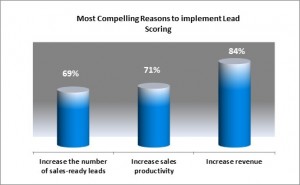More leads are being generated than ever before. Companies today are generating contacts via their web sites, social media resources and other Sales & Marketing efforts. However, the lead conversion rate has been dropping during 2014, according to the Sales Performance Optimization study from CSO Insight. So, what should be the correct process in order to increase the efficiency? Lead scoring is the answer.
As CSO Insights defines: “Lead Scoring is the methodoly used in marketing automation systems in order to rank prospects on a scale that indicates their sales-readiness”. Given that every prospect and customer is different, the Marketing and Sales teams should be able to tell apart leads that may be ready to purchase over a minimum period of time and those who will want to examine all of their options before making a decision. Lead Scoring also reduces the cost per lead by improving the probability to reach the most appropriate leads and eliminating the least appropriate ones.
The integration of Sales and Marketing -a subject already discussed in another post- will be essential to make a scoring system possible. Both departments will have to come together and agree upon the factors that will determine how far along in the sales funnel a lead has advanced.
Reasons why you should implement a Lead Scoring system
The reasons to do so are many: effective use of resources, reducing costs per lead, increasing the number of qualified leads and conversion rates, reducing the sales cycle… The following table shows the three main reasons to implement it, according to a study made by Gleanster in 2011, based on 135 surveys.
 3 steps to implementing a Lead Scoring System
3 steps to implementing a Lead Scoring System
- Agree Lead Scoring rules: both the Marketing and Sales teams need to clearly define the parameters of a lead scoring program. Organizations have to define their definition of hot, warm and cold leads. Parameters as revenue, role, web activity, industry or location are just a few of the many scoring criteria. In most organizations, lead quality is determined by two major factors: demographics and behavior.
- Look for a tool that can help you implement the Lead Scoring policies. Usually, Lead Management tools have some scoring capabilities that can help you detect the lead that are ready to be contacted by Sales.
- Automate the nurturing process that will move the leads along in the Sales funnel. The joint work of Marketing and Sales should determine the steps needed to make the leads become more sales-ready. The Sales team becomes more efficient because they only pursue hot leads, while the cold and warm lead get nurtured via automation.
Delio is a Lead Management platform designed specifically for the B2C market. Its lead scoring and automated nurturing capabilities make it the ideal tool for companies to sell more and sell better.








